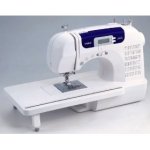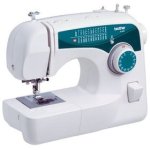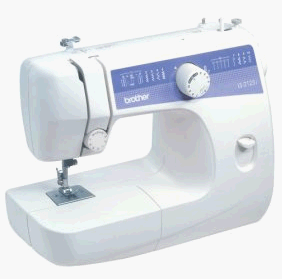Below are the few features I feel are the most important to me when looking for a sewing machine. If you want to know how to choose the best sewing machine, click here a more detailed account.
Drop-in Bobbin
No more fumbling underneath the machine to insert the bobbin, but you can open a section right on top to drop the bobbin in. You’ll see the thread running low through a clear panel.

Automatic Buttonholer
Also called a one-step buttonholer, and is a feature that most electronic and computerized sewing machines have. Sews your buttonhole in a step without you having to turn the fabric around. Some can adjust the buttonhole size according to the button you put into a slot in the machine.

Needle Threader
Threads your needle by itself. If you have had a hard time squinting and pricking your finger in the needle-threading process, this is a life-saver. But some users didn’t like it because they are much defter than the machine.
Adjustable Presser Foot
Now you can adjust how tight the machine holds your fabric. This is important if you sew many kinds of fabric like me. Thin fabrics do not deserve the same treatment as thick ones.
Sound
Sewing machines make a certain amount of noise while sewing. Do you need to be quiet when you sew? When your baby is asleep, maybe? If that is the case, you shall have to get a sewing machine that is very quiet so that you can sew at any time of the day.
Size and Weight
Traveling around with my sewing machine is a bother, so I don’t do it. But if you need to carry it to sewing class or stow it away each time after use, the size and weight of the machine is definitely something to note. Because I sew a lot, I just cleared out a space at home specially for sewing so that I can just leave my stuff there.
Manual
The sewing machine manual is VERY IMPORTANT. Check reviews to see whether the model you’re buying has an easy understandable manual. Don’t chuck it in the box and leave it. Instead, as soon as you got your purchase, read the manual thoroughly and try it out with a few pieces of fabric.
Warranty
Sewing machines can and should last a very long time. However, always check for a warranty from the manufacturer. Most machines come with a 25-year warranty or limited warranty.
Related Posts:
- Sewing Machine Review – Main
- Brother XL2600I 25-stitch Free-arm Sewing Machine – Best Basic Sewing Machine
- Singer 7442 Electronic Sewing Machine – Best Value Electronic Sewing Machine
- Brother ES2000 77-stich – Best Budget Computerized Sewing Machine
- Brother CS6000I Computerized Free-arm Sewing Machine – Best Quilting Sewing Machine
- Singer 7470 Confidence Electronic Sewing Machine – Best User-Friendly Sewing Machine
The Singer 1507 8-Stitch Sewing Machine is a wonderful machine that’s a great deal for its price. I couldn’t be more pleased. My mother-in-law borrowed it to mend her curtains and just called to say she plans to get this machine for herself.

Singer 1507 8-Stitch Sewing Machine
Pros:
Cons:
Overall: Singer 1507 8-Stitch Sewing Machine is a great sewing machine for beginners and basic sewing. It’s clearly made with convenience in mind, evident from the ‘little touches’ included like threading instructions on the machine, storage compartments for accessories, bobbin winder, and even a small bottle of oil.
Just don’t give up on the horizontal spool and you’ve got a handy machine at your disposal.
Further information:
Related Posts:
- Sewing Machine Review – Main
- Brother XL2600I 25-stitch Free-arm Sewing Machine – Best Basic Sewing Machine
- Singer 7442 Electronic Sewing Machine – Best Electronic Sewing Machine
- Brother ES2000 77-stich – Best Computerized Sewing Machine
- Brother SE350 Computerized Embroidery and Sewing Machine – Best Embroidery Sewing Machine
- Brother CS6000I Computerized Free-arm Sewing Machine – Best Quilting Sewing Machine
I’d recommend this sewing machine to anyone! The Singer 7470 Confidence is the easiest sewing machine to use, even for novices. It’s not computerized, nor is it great for heavy quilting or serious embroidering, but it’s the best sewing machine if you don’t need those.

Singer 7470 Confidence Electronic Sewing Machine
Once you’ve got the Singer Confidence on the run, you’ll know what I mean about it being easy to use.
All the Friendly Features!
The auto tension is the best part about it, I should say. No more fiddling with tension dials trying to find the right tension! The machine adjusts itself according to the stitch and thickness of fabric you’re using.
This Singer machine has the Drop & Sew bobbin system which is really convenient. The bobbin is easy to wind and the threading takes no time at all.
Beginners would be glad that the manual has some good explanations, photos and even definitions for jargon. But for intermediate users you don’t really need much help from the manual, except maybe to read up on the twin needle stitch.
Sturdy and Worth Its Price
The Singer Confidence is a bit heavy to carry to sewing classes, but the fact that it’s heavy is what makes it so good! It takes layers and heavy fabrics well enough, though I wouldn’t say it’s the best for quilting. The machine doesn’t clatter like those light ones and it’s quieter than most others.
Although this wasn’t meant for embroidery, it does have simple embroidery patterns. There are loads of stitches to choose from, needle positions, and temporary memory, all of which can be managed from the simple control panel with LCD screen.
If there is anything at all that could be complained about, it could be the reverse stitch button, which you have to hold down until the reverse stitch is done. It’s not cool but not really a problem for most people.
I strongly recommend the Singer 7470 Confidence to those who don’t need computerized machines for embroidery or quilting. It’s good as an entry level machine too, though you may have to stretch your budget a bit. Totally worth it!
Shopping information:
- There is free shipping for Singer 7470 Confidence Electronic Sewing Machine together with an attractive discount now. Get it soon while it lasts!
Related Posts:
- Sewing Machine Review – Main
- Brother XL2600I 25-stitch Free-arm Sewing Machine – Best Basic Sewing Machine
- Singer 7442 Electronic Sewing Machine – Best Electronic Sewing Machine
- Brother ES2000 77-stich – Best Computerized Sewing Machine
- Brother SE350 Computerized Embroidery and Sewing Machine – Best Embroidery Sewing Machine
- Brother CS6000I Computerized Free-arm Sewing Machine – Best Quilting Sewing Machine
Looking for a good electronic sewing machine but don’t want to overspend? I recommend the Singer 7442. This is one fine machine to have for the price. This quality machine is not exactly at a budget price, but it’s still under $200.

Singer 7442 Electronic Sewing Machine
Plenty of Good Features
Let’s talk about the good stuff first. I personally always liked the threading and bobbin systems on Singer machines. This machine is very easy to thread; there is automatic threading if you don’t want to waste 30 seconds poking at the needle’s eye.
The bobbin goes on the top (also called drop-in bobbin) but there is no Drop & Sew feature on this model. I prefer the drop & sew but I wouldn’t mind the extra step of drawing it up for this price. Just lift the presser foot and pull up the loop of thread.
The best thing I like is the automatic tension. I’d like that on every one of my machines because it saves me so much time trying to adjust tension manually. This Singer 7442 can take some heavy fabrics and layers well even though the machine itself is not heavy.
A Bit Lacking in Some Aspects
This sewing machine is not exactly lightweight but good enough to carry around. It doesn’t come with a case though, so people who want to bring it to sewing classes will have to buy a case separately.
Some reviewers complained that the needle always ends up in the up position, but you can manually crank it half a stitch if you want it down. This is a bit of a grumble especially for people who’re sewing fast.
The LED light by the needle is not much use at all; using another light source which is bright enough to light the whole working area will be more practical.
I’d say these complaints aren’t big enough to stop most people from getting a good electronic sewing machine below $200. Singer 7442 gives value for its price.
Shopping information:
- Click here to read more about Singer 7442 Electronic Sewing Machine. There is free shipping available now.
Related Posts:
- Sewing Machine Review – Main
- Brother XL2600I 25-stitch Free-arm Sewing Machine – Best Basic Sewing Machine
- Brother ES2000 77-stich – Best Budget Computerized Sewing Machine
- Brother SE350 Computerized Embroidery and Sewing Machine – Best Embroidery Sewing Machine
- Brother CS6000I Computerized Free-arm Sewing Machine – Best Quilting Sewing Machine
- Singer 7470 Confidence Electronic Sewing Machine – Best User-Friendly Sewing Machine


